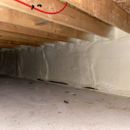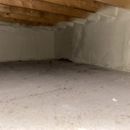Closed-Cell Spray Foam Pulling Away from Foundation Walls in Crawlspace
We are currently building a new custom home in upstate NY (zone 6) with open-cell spray foam insulation above grade and closed-cell in the crawlspace.
The installation in the crawlspace was done on two separate occasions because the first time it was only R14 when R23 is called in the spec so the crew needed to come back and add an additional layer.
During the installation in late April, the condition in the crawlspace was cold (48F) and humid, wet foundation walls to a point mold had formed in certain areas – relative humidity at 98% (measured by a hygrometer). There was also sitting water (a puddle) from earlier in the process that was never fully drained through the foundation drain.
After the spray foam installation, everything seemed fine until it got warmer outside and a dehumidifier was installed by the crew. Recently, we noticed the insulation coming off the foundation walls at the base around the perimeter of the foundation. See photos. The relative humidity is now at ~45% w/ 70F with the dehumidifier running non-stop. The house is still under construction but in the final phases.
Has anyone ever seen this and can reflect on the severity of this issue and to what extent it compromises the insulation properties?
Thanks!
GBA Detail Library
A collection of one thousand construction details organized by climate and house part












Replies
This says your substrate shouldn’t be higher than 18% moisture. Certainly not wet.
What are the odds they keep the truck and drums in 70-80 degree temperature overnight?
https://www.idi-insulation.com/tips-apply-spray-foam-insulation-cold-temperatures-winter-weather/
Looks it was sprayed over wet concrete. This is something you should never as it tends to shrink and separate. You might want to cut out a section to see if you have decent adhesion to the concrete behind.
The reason you spray a foundation wall like that is to air seal, you want to make sure you have good adhesion. They might need to cut back the bottom of the foam and re-spray.
My guess is the wall was wet when sprayed. Spray foam won’t properly adhere to an overly damp surface. If you had standing water and wet walls that’s almost certainly your problem here. I agree with Akos that you should test the adhesion in other places. You’ll probably find poor adhesion in some areas. Applying spray foam to overlay damp areas is similar to painting a wall without primer: the paint sticks in some places, obviously peels in others, and is barely sticking in random spots.
Spraying at 48F is a bit cold, but probably not enough that the temperature was the main issue. An exception is if it was 48F ambient but the wall was much colder than that. Overly cold surfaces cause problems too, and if it’s really cold you can get problems with the curing process itself.
Bill
Ales,
Are you planning to use open cell at the roof line? If so, be sure to read this article before proceeding: https://www.cnn.com/videos/politics/2020/08/19/barack-obama-dnc-2020-speech-full-video-vpx.cnn
> everything seemed fine until ....
Anyone have a link to info about the long term, real-world air sealing effectiveness of spray foam? Ideally including changing temp/humidity, less than laboratory perfect application, weak substrates, building movement, etc.